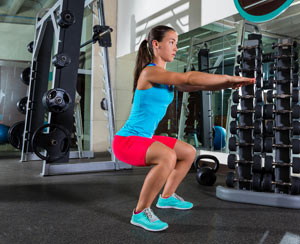
Although wishing won’t get you the shapelier butt you’re longing for, there are a few great butt-firming exercises that are almost that simple.
Squats
Squats are one of the simplest exercises to perform, but there’s no denying they will work your glutes from all sides.
Start out in a standing position with your toes facing forward and your feet about shoulders’ width apart.
To perform the squat, hold your upper body as vertical as possible and press your heels into the ground as you gradually bend at the knees. It should look as though you’re cautiously sitting down. As you lower yourself into the squat, aim for getting your legs to a 90-degree bend, but don’t let your knees extend past the tips of your toes.
Return to the starting position by pushing your heels into the ground again and using the same slow and controlled movement to straighten your knees.
Do two sets of 10 – 20, depending on your ability.
Stationary lunge
The stationary lunge is an easy but effective way to lift sagging butt muscles.
Start out in a standing position with your arms at your sides and your feet together.
To perform the lunge, hold your upper body as vertical as possible and step forward with your left foot. As your left heel hits the ground, slowly bend your knee to a 90-degree angle as you lower your torso. But be sure your knee doesn’t extend beyond your ankle. Your right leg should now be extended out behind you with your right heel slightly off the ground.
Return to the starting position by pushing your left heel into the ground and straightening your knee as you bring your feet back together.
Do 10 – 15 reps, either by alternating sides or completing an entire set with one leg at a time.
Hydrant lift and side extension
The hydrant lift and side extension will give your butt that firmness you’re looking for.
Start out on all fours with your arms bent so that your knees and elbows are on the ground.
To perform the hydrant lift and side extension, keep your torso parallel to the ground and knees bent at a 90-degree angle. Keeping your leg at a 90-degree angle, slowly pivot your hip, raising your left knee toward the ceiling until it is parallel with the ground.
From this position, straighten your knee and extend your left leg out to the side.
Return to the starting position by bending your knee and lowering your leg back to the ground.
Do two sets of 15 – 20 on each side.
Glute kickback
The glute kickback is another way to give your butt an extra lift.
Start out on all fours, with your arms bent so that your knees and elbows are on the ground.
To perform the glute kickback, keep your torso parallel to the ground and slowly extend your left leg out behind you. Flex your foot and keep your leg straight as you raise your leg toward the ceiling. Be sure to squeeze your glutes and pause when your leg is parallel with your torso.
Return to the starting position by steadily lowering your straight leg to the ground and then bending your knee to pull your leg forward.
Do two sets of 15 – 20 on each side.
For more articles go to http://lifesportfitness.lifestyleezine.com

 As babies and toddlers, we were able to squat for hours. It is actually considered a resting position in many cultures. A person’s ability (or inability) to squat is a good indication of his or her physical condition. One must not only possess a flexible body, but also have well-developed leg and back muscles. Although we were exceptionally good at it long ago, the lack of practice in squatting could render a person incapable of squatting, or to maintain the squatting position for more than a minute. Full squatting involves resting one’s weight on the feet with the buttocks resting on the backs of the calves. Most western adults cannot place their heels flat on the ground when squatting because of shortened Achilles tendons largely caused by habitually sitting on chairs or seats and wearing shoes with heels (especially high heels). For this reason the squatting position is usually not sustainable for more than a few minutes as heels-up squatting is a less stable position than heels-down squatting. With continual practice, we can get back to the full squat position we were used to as a child.
As babies and toddlers, we were able to squat for hours. It is actually considered a resting position in many cultures. A person’s ability (or inability) to squat is a good indication of his or her physical condition. One must not only possess a flexible body, but also have well-developed leg and back muscles. Although we were exceptionally good at it long ago, the lack of practice in squatting could render a person incapable of squatting, or to maintain the squatting position for more than a minute. Full squatting involves resting one’s weight on the feet with the buttocks resting on the backs of the calves. Most western adults cannot place their heels flat on the ground when squatting because of shortened Achilles tendons largely caused by habitually sitting on chairs or seats and wearing shoes with heels (especially high heels). For this reason the squatting position is usually not sustainable for more than a few minutes as heels-up squatting is a less stable position than heels-down squatting. With continual practice, we can get back to the full squat position we were used to as a child.